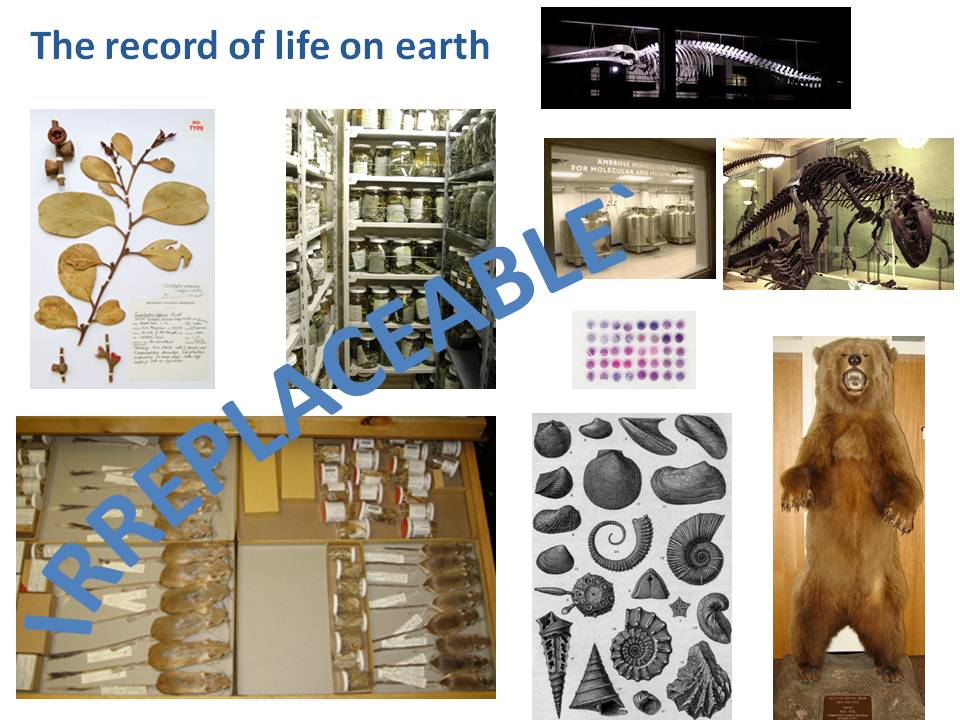Hidden Treasures
By Nadine Lymn, ESA director of public affairs

Slide from Michael Mares' presentation at June 5 congressional briefing sponsored by the National Science Collections Alliance.
Imagine you get up one morning and go outside to fetch your paper. As you reach to pick it up, a strange spider bites you. Your neighbor is bitten too. Now you’re both dying because no one can identify these spiders and therefore can’t administer anti-venom that might save you. This was the dramatic scenario Michael Mares conjured up for the audience during a June 5 congressional briefing, “Digitizing Science Collections: Unlocking Data for Research and Innovation” sponsored by the Natural Science Collections Alliance (NSCA).
Mares, director of the Sam Noble Oklahoma Museum of Natural History, was drawing his gripping story from a real-life mystery that is unfolding in Assam, India, where several people were bitten by tarantula-like spiders. According to The Washington Post, two people died, although possibly from the wound-cutting treatment they received for the spider bites. Local researchers have been unable to identify the thumb-sized spiders, saying they look like a new species. Mares’ point was to demonstrate the value of preserving natural science collections. New species, some of them potentially hazardous, will arise and natural history collections can help shed light on what they are and how to effectively respond.
The United States has the largest natural science collection in the world, with collections found in every state. These include samples of life on Earth collected over centuries—everything from bacteria to animal and plant specimens to fossil skulls of long extinct creatures such as the saber-toothed tiger. National and state museums, universities, botanical gardens and zoos are among those institutions that house these science collections.
Natural science collections can hold the key to solving numerous mysteries including identifying the species of birds that have collided with planes such as US Airways Flight 1549, allowing for better understanding of how to avoid such encounters (see Smithsonian video below).
Collections also played a significant role in understanding the negative impact of the insecticide DDT on birds of prey, such as the peregrine falcon and bald eagle. By comparing the birds’ eggs with that of the same species’ eggs held in collections, researchers found the evidence that DDT was causing eggshells to thin, making them highly breakable and nearly driving both these species to extinction before DDT was banned. Science collections have also helped identify the origins of diseases including Ebola and Hantavirus. They can play a significant role in biosecurity, emerging diseases, and identifying exotic non-native species.
But for all the benefits they can bestow and the billions of dollars that the country has invested in gathering these collections, they suffer from a myriad of problems. Usually locked out of sight in the back rooms of museums or stored in ramshackle, substandard buildings, US science collections are a hidden treasure, largely unseen, insufficiently staffed and maintained and often inaccessible to researchers, policy makers, and other potential users of the information they can confer.
The facilities holding the nation’s collections desperately need to be modernized, fitted with environmental controls to prevent deterioration and their collections need to be digitized to allow for greater accessibility. Of course, all this costs money, which is especially hard to come by now, at both state and federal levels.
One success story is that of Oklahoma, where residents understood that collections are part of their heritage and merit preservation. In the 1940s through much of the 1990s, collections were housed in a horse stable, a gun shed and scattered among various academic buildings of the University of Oklahoma. The efforts of a group of concerned citizens led to the passage of a $5 million city bond, leading to more funds and ultimately, a new facility—the Sam Noble Oklahoma Museum of Natural History.
At the federal level, the National Science Foundation is providing funding for some 130 facilities to digitize their collections. iDigBio is the hub of this effort. And in 2008, the White House Office of Science and Technology Policy released the report, “Scientific Collections: Mission Critical Infrastructure for Federal Science Agencies.” The report describes the science collections managed by the federal government, how the collections are used and recommendations to preserve and manage them to benefit the nation as well as the scientific enterprise.
Michael Mares also spoke of the need for a new generation of taxonomists—those who are trained to identify, name, and classify organisms. Many of the country’s taxonomists are old like he is, said Mares, and “if you can’t identify something, you don’t know anything.”